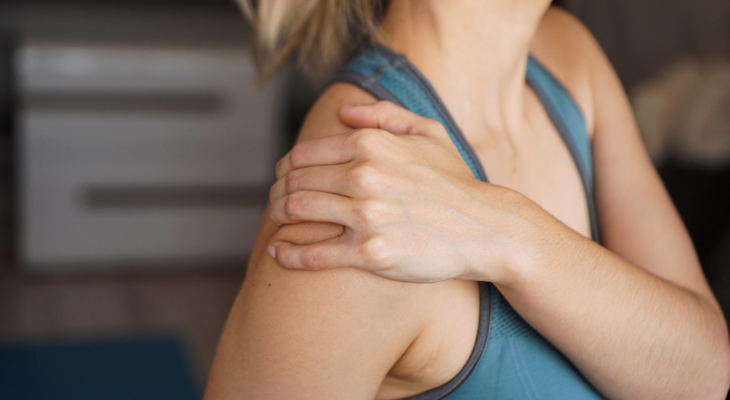
How Your Chiropractor Can Help with a Rotator Cuff Injury
Your shoulder pain could be caused by an injury to the soft tissues in your rotator cuff. Rotator cuff injuries often occur in athletes but can affect anyone. No matter the cause of your injury, your chiropractor offers treatments designed to relieve pain and increase range of movement.
Causes and Symptoms of Rotator Cuff Injuries
The muscles in the rotator cuff stabilize your shoulder joint, allowing it to move easily. Rotator cuff injuries occur when a tendon that connects the shoulder muscles to the bone tears or becomes strained or inflamed. An injury can also happen if the bursae in the shoulder become inflamed. Bursae are small fluid-filled sacs that help the tendons and bones move smoothly.
You may be more likely to develop a rotator cuff injury if you:
- Do Repetitive Work. A job or hobby that involves repetitive motions increases your risk for a rotator cuff injury. Hair stylists, painters, construction workers, and people who lift heavy objects are at risk, as are weightlifters, tennis players, and baseball players.
- Are 40 or Older. Blood supply to your tendons decreases as you age, making it harder for your body to repair damage. Your risk for developing a rotator cuff injury continues to increase as you get older. According to MedlinePlus, most people have rotator cuff tears by age 80.
- Have an Accident. A fall or injury can damage your rotator cuff.
- Have a Family History of Rotator Cuff Issues. You may be more likely to develop rotator cuff issues if your family members have had these injuries.
Rotator cuff injuries are painful and may make it difficult to raise your arm. Your arm may also feel weak, or you might notice numbness or tingling in your arm or hand.
Treating Your Rotator Cuff Injury with Chiropractic Care
Chiropractic care provides a natural way to treat your rotator cuff injury. Treatments could decrease your reliance on pain medication and help you avoid surgery. Your chiropractor offers several helpful treatments for rotator cuff injuries, including:
- Spinal Manipulation. Spinal manipulation may be recommended if vertebrae in your spine are misaligned. The hands-on treatment realigns the vertebrae, decreasing pressure on the muscles and tendons in your shoulder. Patients who received spinal manipulation during a study published in Manual Therapy, Posturology & Rehabilitation Journal reported decreased pain and a significant improvement in abduction movement in both shoulders. Abduction involves moving the shoulder away from the body. Spinal manipulation may also decrease inflammation and reduce pressure on nerves.
- Heat and Ice. Heat and ice are helpful therapies that ease pain or inflammation in the shoulder.
- Massage. Massage relaxes stiff muscles and improves the range of motion in your shoulder. During massage therapy and other chiropractic treatments, your body's production of pain-killing endorphins and serotonin increases.
- Ultrasound Therapy. Ultrasound waves heat the deep tissues in your shoulder, which promotes healing while easing pain and inflammation.
- Trigger Point Therapy. Trigger points are hard knots that may form in the muscles after a rotator cuff injury. The knots often cause radiating pain. During trigger point therapy, your chiropractor applies steady pressure to loosen the muscle fibers in the knots. Trigger point therapy and massage also break up scar tissue that can limit shoulder mobility and flexibility.
- Exercises. Your chiropractor may show you a few exercises you can do at home to support your treatments. The exercises strengthen the muscles in your rotator cuff without straining them. When your muscles are stronger, you may be less likely to re-injure your rotator cuff. In a study published in the International Journal of Osteopathic Medicine, researchers revealed that shoulder exercises combined with spinal manipulation decreased pain intensity and disability after the first two weeks and from the fourth to sixth week.
Wondering what you can do about your rotator cuff symptoms? Relieving your pain can be as simple as scheduling an appointment with our office.
Sources:
MedlinePlus: Rotator Cuff Injuries, 1/8/2024
https://medlineplus.gov/rotatorcuffinjuries.html
Manual Therapy, Posturology & Rehabilitation Journal: Effect of Spinal Manipulation on Shoulder Pain and Range of Motion in Individuals with Rotator Cuff Tendinopathy, 11/12/2016
https://www.mtprehabjournal.com/revista/article/view/1036
Science Direct: International Journal of Osteopathic Medicine: Spinal Manipulation Combined with Exercise Therapy Could Be More Effective than Exercise Therapy Alone for Shoulder Pain and Disability: A Systematic Review and Meta-Analysis, 12/2023
https://www.sciencedirect.com/science/article/abs/pii/S1746068923000329
Cureus: Osteopathic Manipulative Treatment for a Chronic Rotator Cuff Tear: A Case Report, 9/30/2023
